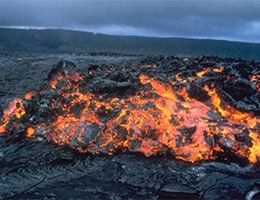 The notion of magma comes from a word in the Greek language that can be translated as “paste” . The term refers to the molten rock mass found inside the planet Earth .
The notion of magma comes from a word in the Greek language that can be translated as “paste” . The term refers to the molten rock mass found inside the planet Earth .
Magma is a mixture of solid, volatile and liquid materials . When it cools, it crystallizes and consolidates, giving rise to igneous rocks . When crystallization occurs inside the Earth , these are intrusive or plutonic rocks ; On the other hand, if the magma rises to the surface, it becomes lava and only then cools, generating effusive or volcanic rocks .
Another name by which igneous and volcanic rocks are known is magmatic rocks . It is important to highlight that both types are formed from magma and that the main difference between them is the medium in which they are formed. Volcanic eruptions, on the other hand, usually form after an eruption and the process is much faster than those that arise below the surface.
Of the more than seven hundred kinds of igneous rocks that have been documented, most formed beneath the Earth's surface . Among the most common we can mention diorite, andesite, rhyolite, granite, basalt, gabbro and porphyry.
Magmatism is the process of magma formation. It generally takes place on the edges of tectonic plates, below the oceanic ridges, although it can also occur in areas located inside the plates and in subduction areas.
When high temperatures are combined with high levels of pressure , rocks fuse and become magma. This substance can only be found underground since, when it reaches the outside, it is called lava .
Magma is usually concentrated in underground chambers (so-called magma chambers ). There the molten mass is maintained, which includes a liquid part, fragments of crystals and rocks and different dissolved gases. Magma chambers feed volcanoes .
 Many times volcanic eruptions occur when the vapor pressure of gases becomes greater than the pressure exerted by the solid rocks that keep the magma confined. This generates the appearance of multiple bubbles that try to “escape” until the eruption takes place and the magma is expelled as lava.
Many times volcanic eruptions occur when the vapor pressure of gases becomes greater than the pressure exerted by the solid rocks that keep the magma confined. This generates the appearance of multiple bubbles that try to “escape” until the eruption takes place and the magma is expelled as lava.
Broadly speaking, we can describe three types of magmas, which are granitic, andesitic and basaltic. Granitic magmas have the lowest melting point of the three and can generate large plutons (plutons are masses of plutonic rocks that fit into the Earth's crust). Its origin takes place in orogenic zones such as andesites, although it starts from one of the other two magmas when they penetrate and melt metamorphosed sedimentary or igneous rocks whose composition is altered when the magma is incorporated.
Andesitic magmas , on the other hand, have a percentage of silica less than sixty and a series of hydrated minerals, among which are several belonging to the biotite and amphibole groups. These types of magma occur in any subduction zone, both oceanic and continental crust .
Regarding basaltic magmas , the most common of the three, we know that they can be of two types: alkaline, with a high level of potassium and sodium, generated in internal areas of the tectonic plates; tholeiitic, with a silica content of less than fifty percent and arising in the mid-oceanic ridges (the underwater elevations found in the middle zone of the oceans).
